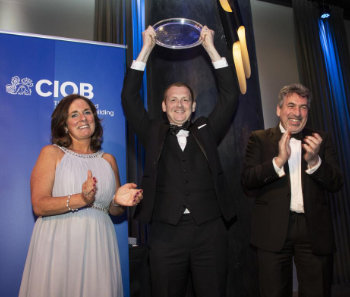CIBSE Case Study Bushbury Hill Primary School
--CIBSE 14:58, 29 July 2014 (BST)
Article from the May 2013 edition of the CIBSE Journal written by Andy Pearson.
Contents |
[edit] Introduction
To achieve Passivhaus status, the design team at Bushbury Hill Primary School had to target unregulated energy use in the kitchen and produce a super-airtight, insulated envelope that wouldn’t overheat. Andy Pearson explains how Architype and E3 stepped up to the challenge.
Having successfully completed a series of low-energy school designs for Wolverhampton City Council, the architect-engineer design team of Architype and E3 Consulting Engineers set out to raise the bar with their next project: Bushbury Hill Primary School. The team set out to design the new school to Passivhaus standards.
In addition to meeting the rigorous technical demands of the Passivhaus Institute, the client insisted that a Passivhaus scheme would have to be completed within the established project timescale and within the existing £4.2m local authority budget allocated to the new school.
To their credit, the team excelled in the task. The Passivhaus solution developed by the team is a handsome timber and brickclad school where the building works had to ensure a comfortable learning environment without expensive energy saving addons. This pragmatic, low energy solution was recognised at the CIBSE Building Performance Awards, where the scheme won the New Build Project of the Year (value up to £5m) category. The judges said the scheme demonstrated ‘Good energy performance without green bling’.
To design a low energy Passivhaus standard school capable of being constructed within the confines of a conventional building budget required an extremely efficient and cost-effective design solution. Unsurprisingly, the low energy strategy has informed and influenced every decision about the building’s form and servicing strategies. ‘As architects, what we like about Passivhaus is that we work more closely with the engineers from early in the design to ensure the building does all the hard work in creating occupant comfort and saving energy without the need for a lot of complicated add-on stuff later in the design,’ says Jonathan Hines, director of architect Architype.
A low energy solution was developed using Passivhaus Planning Package (PHPP) analysis software. The school’s two-storey form, for example, is the result of PHPP. Two rows of classrooms are arranged at angles to create a wedge-shaped double height activity street at the heart of the school. To the East of the street is a double-height school hall. ‘The two-storey, timber-framed solution is more compact and hence more energy efficient because the ratio of external area to floor area is better,’ Hines explains.
In addition, the wedge-shaped building has been designed to take advantage of solar gain in the winter by orientating the school’s main elevation to face south. Most of the classrooms are on this elevation. Brise soleil and an overhanging roof limit solar gains and prevent these rooms overheating in summer. East and west facing glazing is kept to a minimum because of the difficulty in controlling solar gain on these elevations.
The building’s low energy credentials are further enhanced by the exceptionally high levels of insulation present in the building’s fabric. All elements exceed minimum Building Regulations requirements: exterior walls have a U-value of 0.13W/m2/°C, the roof 0.10W/m2/°C, and the U-value for the ground floor is 0.06W/m2/°C. The windows and doors are triple glazed with U values of 0.9W/m2/°C and 1.0W/m2/°C, respectively. In addition, careful detailing has eliminated unwanted heat loss from thermal bridges.
The scheme is also exceptionally airtight. Design workshops were used to develop robust details early in design development, which were continued through the construction phase with the contractor, Thomas Vale. With intelligent detailing and careful construction, the air leakage is limited to an incredible 0.53m3/hr at 50Pa, a 2,000% improvement on Building Regulations.
Knowing they had an airtight, energyefficient building envelope enabled the team to develop an elegant, simple ventilation strategy. There are two ventilation modes: winter and summer. In winter, a mechanical heat recovery ventilation (MHVR) system supplies 5,400m3/h of pre-warmed fresh air to the classrooms at the rate of 18m3/h per person. This fresh air is then drawn through the classrooms and out to the street through acoustic transfer grilles. From the street, air is returned to the MHVR unit where up to 80% of its heat energy is removed before it is exhausted.
In summer, the MHVR unit is turned off and natural ventilation alone can keep the building comfortable. In the street, high level windows and grilles open to allow warmed air to escape to outside. The escaping air pulls in fresh air from the classrooms through the transfer grilles. Manually openable windows and room-height ventilation grilles in the classrooms ensure sufficient ventilation to maintain comfortable conditions.
The ventilation grilles are unusual in that they are effectively louvres set into the wall with a door behind that can be opened or closed by the teacher using an electronic actuator to control ventilation. This interconnected system of grilles and louvres allows secure ventilation and enables the system to be used at night to pre-cool the building in hot weather. This solution eliminates the need for mechanical cooling, while providing high levels of fresh air.
The exception to the natural ventilation strategy is the building’s main assembly hall. Because this is occupied intermittently and the occupancy can vary from one class of 30 to all 230 pupils for school assembly, this room is fitted with a CO2 sensor and a supply and extract fan. When the CO2 sensor calls for fresh air, the fan draws air into the room from the street. When the sensor detects the hall is empty, the fans turn off to stop the system supplying fresh air to an empty room.
This simple strategy enables fresh air to follow the pupils as they move out into the street or to the hall. If the children are not in the classroom, then all the fresh air will still be available when it is drawn into the street. Likewise, if the children are all eating lunch in the hall, then the fresh air in the street will be drawn into the hall. ‘Because the building fabric is so airtight, this solution enabled us to keep the plant size and distribution ductwork to a minimum,’ says Andy Jarvis, a partner at E3 Consulting Engineers.
Modelling and analysis of the occupied spaces demonstrated that the scheme complied with the overheating recommendation in Building Bulletin 101: Ventilation of School Buildings that the air temperature in occupied spaces should not exceed 28°C for more than 120 occupied hours a year. In fact, modelling predicted that the maximum time any space would exceed 28°C was 35 hours a year, well within target. The ventilation solution is very much appreciated by the school’s head teacher Leigh Smith: ‘We can see the benefit of the building’s ventilation design, the spaces are so comfortable and the pupils just love it,’ she enthuses.
Like the ventilation system, the ventilation plant is simple. A single MVHR unit consisting of a supply and extract fan and a heat-wheel, for heat recovery, supplies all the fresh air. The unit does not have a heater battery; instead the fresh air heating requirement is offset using a simple roombased, LPHW radiator system fed from a pair of condensing boilers.
To meet the heat demand the school is fitted with conventional radiators run at low temperature, rather than expensive low surface temperature units. These warm the classrooms while enabling the boilers to run in full condensing mode. The heating circuit has a high temperature differential, typically 50°C flow 30°C return, to keep flow rates to a minimum. All heating pipework is highly insulated to prevent uncontrolled heat loss.
A separate, dedicated supply and extract system is used to ventilate the kitchen. Because unregulated energy use is included in a Passivhaus design, it was important to minimise the kitchen’s energy consumption. School kitchens typically use gas-fired cooking appliances. However, for this project the caterers were persuaded to use electric induction cooking, which means there are no combustion gases to be removed and waste heat from around the pans is minimised (see box: Turning off the gas).’The caterers were not too keen on the idea at first, but it has turned out to be a huge success both in terms of energy use and comfort for the catering staff,’ explains Hines.
In addition to reducing energy consumption in the kitchen, the designers also set about minimising lighting and ICT loads. The form of the building ensures that most spaces have high residual light levels to minimise the need for artificial lighting. When light is needed it is supplied predominantly from linear fluorescent lamps. These are switched on and off manually; presence detection ensures lights will turn off when rooms are empty. The team also worked closely with the ICT consultant to ensure low energy use equipment was selected for the school.
One area of unexpected energy consumption that was a particular challenge was in the sprinkler room. Wolverhampton City Council has a policy that all buildings have sprinklers fitted for life safety. Bushbury Hill’s sprinkler water-storage tank and diesel pump are located in a standalone building situated near the perimeter of the site. ‘The amount of energy needed just to frost protect the sprinkler system caught us out,’ admits Jarvis. He says that on subsequent schemes, fabric insulation for the sprinkler room will be improved and that improvements to Bushbury Hill, too, are being considered.
When the building was handed over to the teaching staff in October 2011, the architect and contractor spent time explaining the principles behind the design and how to operate the building to its new occupants. They also issued staff with this information in a booklet. However, some users have struggled to understand the control strategy. ‘We’re trying to use the same design team to address the issues of over-complication for the users,’ explains Jarvis.
Equally importantly in ensuring the success of the scheme is the design team’s access to the building’s sophisticated Trend BMS system. This enables them to continue to monitor the building in use throughout the year. The team is still tweaking systems to optimise performance; the controls, for example, had to be reconfigured after the 2012 spring heatwave led to some spaces becoming uncomfortably warm because of the high solar gain from the low-angled sun.
Teething problems aside, this highly successful design received full Passivhaus accreditation. More importantly from the council’s perspective, the low energy solution has resulted in minimal energy bills, cushioning them from the impact of future energy price hikes. Not bad for a school that cost £1,768/m2 to build.
If further endorsement were needed for this award-winning, low-energy, low-cost school, the client has engaged the same team to work on its next school project – and this time the client has specified a Passivhaus solution. ‘This solution has the making of a potential low energy model for school buildings,’ says Jarvis.
[edit] Turning off the gas
As energy use is driven down elsewhere in the Passivhaus school, the power consumed in the kitchen becomes increasingly significant. A major challenge at Bushbury Hill was to design a low energy catering kitchen.
Even the relatively small kitchen at Bushbury is full of energy consuming, heat generating equipment, including a freezer, fridge and cooking ranges and ovens. In addition to the energy consumed by this equipment, the heat it generates can be substantial, particularly in a wellinsulated kitchen.
Heat is usually removed from a kitchen by the kitchen hood. This performs a multiple role: in addition to removing heat from the cooking equipment, it removes vapour and other particulates and where gas is used for cooking. The hood also removes the products of combustion and helps keep the kitchen at a lower pressure relative to the rest of the building to stop the spread of smells.
Based on the proposed equipment, a conventional kitchen design would have required a cooker hood to extract 3,600 m3/h from the kitchen. It would also require the same amount of replacement air supplied to the kitchen; this would need to be heated to a minimum of 12°C in winter to ensure it does not cause discomfort to the caterers. Put simply, the energy demand for a conventional kitchen ventilation would have been 10kWh/m2/year, two thirds of the Passivhaus Institute’s 15kWh/m2/year total heat demand target for the school.
At Bushbury, Passivhaus consultant Nick Grant, principal of Elemental Solutions, working with building services engineerAlan Clarke, set out to design a catering kitchen suitable for a Passivhaus school. The fi rst step in developing a low energy kitchen was to select low energy fridges and freezers to minimise their heat outputs. Next, Grant and Clarke set about minimising the heat output of the cooking equipment with an allelectric solution based on induction hobs. These only lose about 25% heat to the kitchen, whereas gas hobs lose almost 100%.
The all-electric strategy enabled the total ventilation rate to be reduced by a third, to 2,400m3/h. In addition, the heat produced in the kitchen was used to preheat the incoming fresh air using an easy to clean run-around coil system. The supply air system also includes a heater coil from the school heating system for times when the heat output from the kitchen is too low to bring the supply air up to temperature.
The solution worked well. In fact, the catering company is so impressed with the comfortable conditions in the kitchen that they are looking at using a similar system in other kitchens they operate.
[edit] Measured performance
Thermal energy: 15kWh/m2 (gas)
Hot water: 12kWh/m2 (gas) Lighting: 14kWh/m2 (electric) Power and plant: 14kWh/m2 (electric) Kitchen: 7kWh/m2 (electric) Sprinklers: 17kWh/m2 (electric)
[edit] Project team
- Client: Wolverhampton City Council
- Architect: Architype
- Passivhaus consultants: Elemental Solutions
- Building services engineers: E3 Consulting Engineers
- Structure: Price & Myers
- QS: Smith Thomas Consult
- Contractor: Thomas Vale
- Construction Certifier: Warm Low Energy
[edit] Find out more
[edit] Related articles on Designing Buildings Wiki
Featured articles and news
Shortage of high-quality data threatening the AI boom
And other fundamental issues highlighted by the Open Data Institute.
Data centres top the list of growth opportunities
In robust, yet heterogenous world BACS market.
Increased funding for BSR announced
Within plans for next generation of new towns.
New Towns Taskforce interim policy statement
With initial reactions to the 6 month policy update.
Heritage, industry and slavery
Interpretation must tell the story accurately.
PM announces Building safety and fire move to MHCLG
Following recommendations of the Grenfell Inquiry report.
Conserving the ruins of a great Elizabethan country house.
BSRIA European air conditioning market update 2024
Highs, lows and discrepancy rates in the annual demand.
50 years celebrating the ECA Apprenticeship Awards
As SMEs say the 10 years of the Apprenticeship Levy has failed them.
Nominations sought for CIOB awards
Celebrating construction excellence in Ireland and Northern Ireland.
EPC consultation in context: NCM, SAP, SBEM and HEM
One week to respond to the consultation on reforms to the Energy Performance of Buildings framework.
CIAT Celebrates 60 years of Architectural Technology
Find out more #CIAT60 social media takeover.
The BPF urges Chancellor for additional BSR resources
To remove barriers and bottlenecks which delay projects.
Flexibility over requirements to boost apprentice numbers
English, maths and minimumun duration requirements reduced for a 10,000 gain.
A long term view on European heating markets
BSRIA HVAC 2032 Study.
Humidity resilience strategies for home design
Frequency of extreme humidity events is increasing.
National Apprenticeship Week 2025
Skills for life : 10-16 February
























